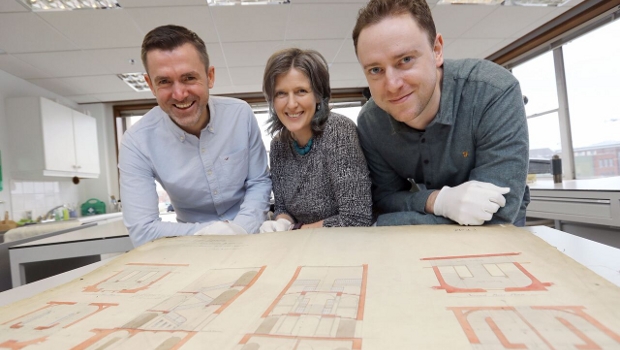Historians and computer scientists at Trinity have unveiled plans to bring Ireland’s Public Record Office back to life by creating a 3D virtual reality reconstruction of the destroyed building and refilling its shelves with searchable surviving documents and copies of the lost records, which have been identified by the team in archives and libraries around the world.
The project, Beyond 2022: Ireland’s Virtual Record Treasury, will be led by the School of Histories and Humanities and the ADAPT Centre for Digital Content Technology in the School of Computer Science and Statistics, the project is a collaboration with The National Archives of Ireland, The National Archives (UK), The Public Record Office of Northern Ireland and The Irish Manuscripts Commission.
The completed project will be made available on the centenary of the Four Courts blaze in 2022. A project website http://www.beyond2022.ie demonstrates the scope of the project and technology involved. This includes an animation of the 3D model being developed which allows the public to experience the magnificent Victorian archive as it was on the eve of its destruction. In December 2018, this website will be enhanced to make the full catalogue of the record treasury available to the public for the first time since 1922. At the launch event today, a virtual reality showcase was demonstrated, which allowed users have a fully immersive, three-dimensional experience of moving through the destroyed building, using VR headsets.
Through detailed historical detective work, the project team is working to recover the information contained in the destroyed archive by identifying and digitising surviving or substitute materials held by archives and libraries around the world. These materials include records that survived the blaze, records that were damaged but not completely destroyed, duplicates of original records now held in partner archives, as well as facsimile images, antiquarian transcripts and summaries of the records made before 1922.
Dr Peter Crooks, principal investigator of the project and Assistant Professor, School of Histories and Humanities, commented on the potential impact of the project: “One of the most ambitious elements of our work is the identification of gold seams of substitute sources. These are hugely significant substitute archival collections held in libraries and archives scattered around the world that can help us recover whole series of records destroyed in 1922. By reconstructing these records, which collectively comprise millions of historical and genealogical facts, we have the potential to transform the evidence base on which Irish history is written. Because the archival collections date from such an early period of history, the reconstruction effort will allow anyone with an interest in researching their families or localities to engage in deep history, reaching back almost half a millennium earlier than most readily available genealogical resources.”
When complete, users will then be able to enter the destroyed Record Treasury itself where the records were held, and move through its 100,000sq ft of archive shelving to the very spot where the record was once stored in order to access any surviving fragments or substitute copies in digital form. The record on the shelf will be a launch pad to substitute records stored in libraries and archives around the globe.
Dr Seamus Lawless, Assistant Professor, Adapt Centre and School of Computer Science, said: “This is a true digital humanities project, with exciting research in both computer science and history. The development of a fully immersive recreation of the archive allows us to blend the physical with the digital, and study how people search for information when using the archive. It will also develop approaches to allow people to seamlessly search for information within the virtual archive, and in archives across the globe that hold related or substitute content. Beyond 2022 has the potential to have significant impact on how people search for, interact with and consume information in virtual reality experiences.”
The Virtual Record Treasury will comprise of a virtual reality reconstruction of the destroyed Public Record Office of Ireland built from original architectural plans and photographic evidence; a complete inventory of survival and loss of the 1922 fire, as well as digitisations of surviving originals and substitute sources; and ‘gold seams’ of evidence offering full reconstructions of whole series of destroyed records based on collections of substitute materials held in partner archives.
An example of a Gold Seam identified by the project is the records of the Medieval Irish Exchequer, tens of thousands of which survive both in Dublin (in the form of 19th century transcripts) and in London (in the form of original copies of the records sent to England for audit by the English Crown). These exchequer records offer searing insights into the politics, warfare, diplomacy, trade and landholding of the later Middle Ages.
A second gold seam identified by the project comprises 22,500 handwritten transcripts of government orders from the Cromwellian era. Considered ‘lost’ for 100 years, these 17th-century records can be reconstructed as the result of a major collaborative effort by institutions in Ireland, the UK and the USA.
John McDonough, director of the National Archives of Ireland, said: “The collaboration between Trinity and its archival partners – The National Archives of Ireland, The National Archives (UK), The Public Record Office of Northern Ireland, and The Irish Manuscripts Commission – is a symbolic moment. It represents imaginative cooperation in order to realise a shared ambition of recreating virtually the holdings of the Public Record Office of Ireland by the year 2022.”
The project is funded by the Irish Research Council.
TechCentral Reporters







Subscribers 0
Fans 0
Followers 0
Followers